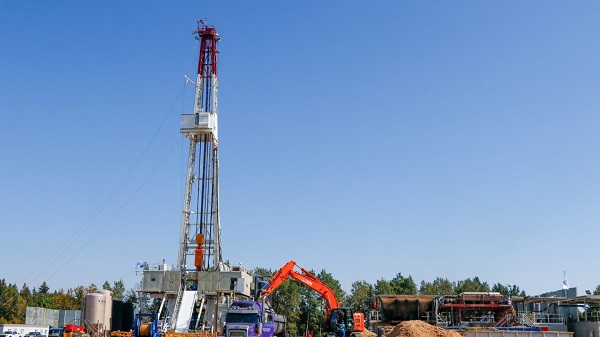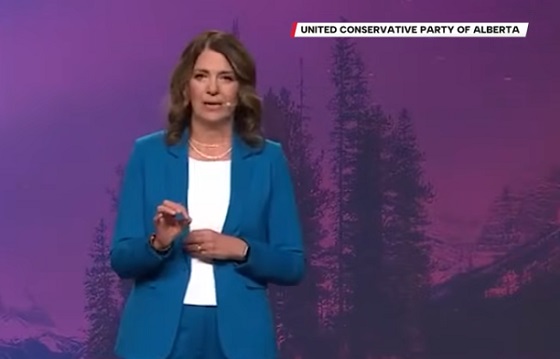Alberta
Premier Kenney addresses the province about a 1.5 billion investment in Keystone XL

From the Province of Alberta
Provincial investment kick-starts KXL pipeline
A $1.5 billion government investment in the Keystone XL (KXL) pipeline project will accelerate construction, ensuring it is operational by 2023
The Government of Alberta has finalized an agreement with Calgary-based TC Energy Corporation to provide financial support to accelerate construction of the KXL pipeline starting April 1. This investment will include $1.5 billion in equity investment in 2020 followed by a $6 billion loan guarantee in 2021. The project is expected to be completed and in service in 2023.
This agreement is the culmination of six months of negotiations, as well as rigorous vetting by government officials and outside industry experts to ensure the success of this project, while minimizing risk to taxpayers.
The government is backstopping the project to enable TC Energy to begin immediate construction on the Alberta portion of the pipeline. This will ensure the earliest possible date of completion. The project will create over 1,400 direct and 5,400 indirect jobs in Alberta during construction and will generate an estimated $30 billion in tax and royalty revenues for future generations of Albertans and Canadians.
“We cannot wait for the end of the pandemic and the global recession to act. There are steps we must make now to build our future focussed on jobs, the economy, and pipelines. Today we are moving forward with a project that is essential to our future prosperity. This investment in Keystone XL is a bold move to re-take control of our province’s economic destiny and put it firmly back in the hands of the owners of our natural resources, the people of Alberta. The Government of Alberta is confident that this is a wise investment. After construction is complete, we will be able to sell our shares at profit. In addition, the project will have a net return of over $30 billion to the Alberta taxpayer through royalties and higher prices for Alberta oil in the next 20 years.”
Once operational, Keystone XL will provide North America with a stable, secure supply of crude oil, reducing reliance on supply from OPEC. The pipeline will carry at least 830,000 barrels per day of Alberta crude, significantly increasing the province’s takeaway capacity and helping to protect the value of its energy resources.
Right now Alberta’s oil export capacity is limited by the lack of pipelines. Without the ability to export more oil, there is no incentive for producers to invest in more production in Alberta. Completing KXL will signal to the oil and gas industry, and to investors around the world, that they have a future in Alberta. Without more pipelines, the future of our oil and gas industry is capped; with today’s announcement, employers and investors should have the confidence to maintain existing projects and to spend new money on new projects.
Construction will begin immediately in Alberta, at the Canada-US border, in Montana, South Dakota and Nebraska.
The Keystone XL Pipeline offers a safe, reliable and environmentally responsible way to deliver crude oil from western Canadian oil fields to Gulf Coast refineries in the U.S. The project will run from Hardisty, Alberta, to Steele City, Nebraska and will cover 1,947 kilometres.
Given the significance of this issue, the Government will present a related motion for debate and vote this week.
Quick facts
Project details
- KXL will provide more than 830,000 barrels per day of crude oil to Gulf Coast Refineries
- Covers 1,947 kilometres from Hardisty, Alberta, to Steele City, Nebraska
- 259 kilometres of pipelines will be constructed in Alberta
- At least 6,800 direct and indirect jobs in Alberta and over 15,000 direct and indirect jobs in Canada
- Project is expected to be completed in 2023
Financial details (CDN$)
- Government of Alberta will contribute up to $1.5B (CAD) in equity investment in 2020
- The government will backstop this project with a $6 billion loan guarantee in 2021
- TC Energy will reimburse the government of Alberta 12 months after oil is flowing through the pipeline
Alberta
Emissions Reduction Alberta offering financial boost for the next transformative drilling idea

From the Canadian Energy Centre
$35-million Alberta challenge targets next-gen drilling opportunities
‘All transformative ideas are really eligible’
Forget the old image of a straight vertical oil and gas well.
In Western Canada, engineers now steer wells for kilometres underground with remarkable precision, tapping vast energy resources from a single spot on the surface.
The sector is continually evolving as operators pursue next-generation drilling technologies that lower costs while opening new opportunities and reducing environmental impacts.
But many promising innovations never reach the market because of high development costs and limited opportunities for real-world testing, according to Emissions Reduction Alberta (ERA).
That’s why ERA is launching the Drilling Technology Challenge, which will invest up to $35 million to advance new drilling and subsurface technologies.
“The focus isn’t just on drilling, it’s about building our future economy, helping reduce emissions, creating new industries and making sure we remain a responsible leader in energy development for decades to come,” said ERA CEO Justin Riemer.
And it’s not just about oil and gas. ERA says emerging technologies can unlock new resource opportunities such as geothermal energy, deep geological CO₂ storage and critical minerals extraction.
“Alberta’s wealth comes from our natural resources, most of which are extracted through drilling and other subsurface technologies,” said Gurpreet Lail, CEO of Enserva, which represents energy service companies.
ERA funding for the challenge will range from $250,000 to $8 million per project.
Eligible technologies include advanced drilling systems, downhole tools and sensors; AI-enabled automation and optimization; low-impact rigs and fluids; geothermal and critical mineral drilling applications; and supporting infrastructure like mobile labs and simulation platforms.
“All transformative ideas are really eligible for this call,” Riemer said, noting that AI-based technologies are likely to play a growing role.
“I think what we’re seeing is that the wells of the future are going to be guided by smart sensors and real-time data. You’re going to have a lot of AI-driven controls that help operators make instant decisions and avoid problems.”
Applications for the Drilling Technology Challenge close January 29, 2026.
Alberta
New era of police accountability

The Police Review Commission (PRC) is now fully operational, giving Albertans a single, independent process to file policing complaints and ensure accountability.
Alberta’s government is putting the province at the forefront of police oversight in Canada with the creation of the PRC. This new commission replaces the current patchwork of police investigating police with one independent body responsible for receiving complaints, conducting investigations and overseeing disciplinary hearings. By centralizing these functions within a single, independent agency, Alberta is ensuring complaints are handled fairly and consistently.
“The Police Review Commission represents a new era in how Alberta addresses policing complaints. These changes are part of a broader paradigm shift where police are no longer seen as an arm of the state, but rather an extension and a reflection of the community they serve. As an independent agency, it is committed to fairness, accountability and public trust, ensuring every complaint is investigated impartially and resolved openly.”
The Police Amendment Act, 2022 laid the groundwork for this new model, establishing a modern approach to oversight built on accountability, consistency and public confidence. The PRC will manage the full complaints process from receiving and assessing, to investigating and resolving complaints related to police conduct, including serious incidents and statutory offences.
“The Alberta Association of Chiefs of Police welcomes the launch of the Police Review Commission as a meaningful step toward enhanced oversight and greater transparency in policing. By ensuring complaints are reviewed fairly and impartially, the Commission will help strengthen accountability and reinforce public trust in Alberta’s police agencies. Police leaders across the province are committed to working with the Commission and our communities to ensure every Albertan has confidence in the integrity of our police services.”
A timely and transparent complaint resolution process is essential for both the public and police. That is why the PRC must complete investigations within 180 days, and if more time is needed, the chief executive officer must publicly report on delays and provide justification. This ensures clarity, predictability and accountability throughout the process. The commission will be arm’s length from government and police services, meaning people can have greater confidence that their complaints will be investigated and resolved impartially.
“Our goal is to build trust in policing by delivering timely resolutions and fair, consistent outcomes that put people first. Every complaint will be reviewed thoroughly and handled with the transparency and respect Albertans expect and deserve.”
The PRC can also initiate systemic reviews related to police conduct or emerging trends without the need for a public complaint, and these reviews must be made public. Together, these measures create a clear, accountable process that strengthens transparency, supports continuous improvement and enhances trust in how police oversight is carried out across Alberta.
“Public safety and the confidence the public has in our police services and service members are incumbent for effective and responsible service delivery. The PRC has been developed so that Albertans may have a responsible and impartial mechanism to voice concerns regarding delivery of policing services in Alberta. I am confident that the PRC will be an inclusive and diverse representation of the communities, so we may better understand the most appropriate and effective way to respond to concerns regarding police services. I look forward to the positive outcomes for the community.”
The commission’s design was informed by engagement with Indigenous communities, law enforcement partners, municipal officials and community organizations, ensuring its structure and training reflect Alberta’s diversity and values.
Quick facts
- The PRC will handle complaints in three categories:
- Level 1: Death, serious injury and serious or sensitive allegations involving all police services in Alberta, as well as peace officer agencies.
- Level 2: Allegations of criminal and other statutory offences involving all police services in Alberta.
- Level 3: Complaints about non-criminal misconduct involving officers employed by municipal and First Nations police services.
- Complaints that fall outside the three categories will be referred to the appropriate bodies or agencies for review.
- The Alberta Serious Incident Response Team (ASIRT) will now operate under the PRC.
-

 COVID-192 days ago
COVID-192 days agoThe dangers of mRNA vaccines explained by Dr. John Campbell
-

 Energy1 day ago
Energy1 day agoCanadians will soon be versed in massive West Coast LPG mega-project
-

 National1 day ago
National1 day agoMedia bound to pay the price for selling their freedom to (selectively) offend
-

 Bruce Dowbiggin23 hours ago
Bruce Dowbiggin23 hours agoSometimes An Ingrate Nation Pt. 2: The Great One Makes His Choice
-

 Alberta2 days ago
Alberta2 days agoKeynote address of Premier Danielle Smith at 2025 UCP AGM
-

 Artificial Intelligence1 day ago
Artificial Intelligence1 day ago‘Trouble in Toyland’ report sounds alarm on AI toys
-

 Alberta23 hours ago
Alberta23 hours agoNew era of police accountability
-

 Business22 hours ago
Business22 hours agoIs there a cure for Alzheimer’s Disease?






